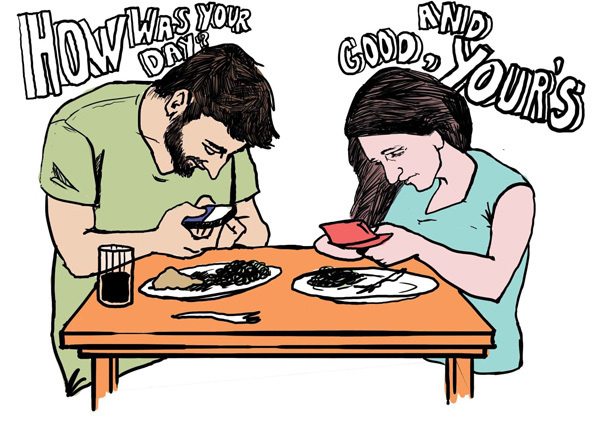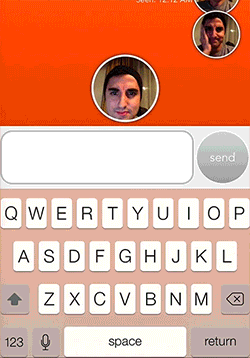What to expect from mobile messengers: video emotions, chats with a microwave and other new features
Mobile instant messengers are not enough. Many instant messengers available for download on Google Play or the App Store provide basic functionality: you can exchange text messages, make voice and video calls, make calls to landlines and mobile phones. However, all this is the basis to which the developers are trying to “tie” their killer features. The ideas of developers “for the future” are very difficult to guess, because not even individual people are working on them - entire teams of designers and programmers, but already now there are a dozen of interesting and promising features that may be appealing to messengers.

The whole direction, which is realized in instant messengers and is gaining popularity - video (or photo) emotions. Programs that implement this feature are also called reaction messengers. It would not be a mistake to call them still self-messengers.

The meaning of the work of these messengers is the active use of the front camera, which provides support for text dialogs with pictures from this camera itself. Thus, users who are in the chat can see how you react to their phrases or replicas. Moreover, the “reactions” can be recorded not only on messages, but also on other actions: for example, on pictures transmitted by means of an instant messenger.
')
The meaning of how the reaction messenger works is conveyed well by this gif-animation:

Video Emotions make text communication more exciting and interactive, however, it is obvious that such a function is demanded mainly by young people who like to “hang” in instant messengers. Since video emotions appeared in messengers quite recently, there is still no consensus on the question of how necessary and useful they are for IM communication. At the same time, no “reaction messenger” is even included in the TOP-100 programs in its category in the same App Store. On the other hand, this feature has potential (after all, young people are the main category of users of mobile messengers), and the appearance of video responses already in common programs is only a matter of time. In the meantime, such applications as React Messenger , Samba , Dumbstruck allow you to experience all the charm of video emotion .
The concept of the Internet of things suggests that with time almost all devices around us will be connected to the Web. And, in general, everything goes to that: household appliances with access to the Internet are already realities (albeit so far expensive realities) of today. For remote control, for the time being, in most cases, the proprietary programs of the manufacturer themselves are used, installed on mobile devices, but you must agree that you have about a dozen applications in your smartphone, each of which is responsible for a specific device (pressure cooker, washing machine, refrigerator, etc.) - dubious pleasure. And what if all of this will be integrated in the framework of a mobile messenger? Apparently, it was exactly such reasoning that was adhered to by LG: at the beginning of the year, the company announced a service for managing HomeChat appliances, operating on the basis of the Line messenger.
How does homechat work? Equipped with access to the network, LG home appliances - TVs, refrigerators, robot vacuum cleaners, ovens - are integrated into the Line and support voice control technology. The user can call or send a message to his vacuum cleaner and arrange cleaning at a certain time, and ask the washing machine to wash the clothes in a “delicate” mode. In addition, you can request the status of devices. For example, check with the washerman how much time is left until the end of the wash cycle.
The convenience that the user receives is obvious, but why should LG use Line? It's simple: the company chose not to spend money on developing the next (extra?) Service, but to use the Line infrastructure. The LG did not disclose details of cooperation with the Line, but I think it is not free.
Of course, it is too early to say that soon all the appliances will be managed using a mobile messenger - the trend is just emerging. However, it is clear that over time, more and more manufacturers of consumer electronics (initially large and then smaller) will offer remote control for their products. And the use of a mobile messenger with a developed infrastructure and millions of users seems to be the most appropriate way to solve this issue.
Since consumer electronics were integrated into Line, various fitness trackers, like smart bracelets, a priori working through a smartphone or tablet, should be integrated into mobile messengers. If now many are sharing their achievements in fitness and sports through social networks, then the future is right behind the messengers. First, it will be possible to share the results not only with friends, but also all users involved in the same sport. And this should motivate much more. Secondly, fitness trainers (or fitness centers, why not?) Using a mobile messenger is more convenient to monitor their wards, than to monitor all social networks.
Another question is which messenger to use to interact with fitness trackers? But this is already a question for the developers: subjectively, who will offer the best implementation of the fitness tracker in his program, he will be the winner.
And what to expect from mobile messengers from the entertainment? Random text / video / voice chats! Choose a user according to specified criteria (gender, age, language) - and go ahead, meet and communicate. If you correctly implement the function, you can "bite off" not only the market share of mobile operators offering anonymous dating through paid SMS, but also dating sites.
Answering machine is a great thing, but in the current mobile it is not properly implemented. It seems that a flexible answering machine that allows you to send different text and voice responses for different users would be demanded by many. Especially those who use the messenger as a means of communication in a business environment.
Another potentially very demanded function is sending by messenger the routes (namely, “to the point” routes, not locations) generated by third-party services. For example, with Bing maps or Google, or Yandex ... Convenience is here in the alternative and implementation features of each specific mapping service.
No one is immune from the problems that arise when using the messenger on the go: you can encounter bystanders or a pillar, and even worse - get hit by a car. To avoid such troubles, transparent windows were invented: the text of the chat is superimposed on the image received from the rear camera. Thus, the sheep are intact (no need to be distracted from the interesting chat), and the wolves are fed (the obstacles on the way are easy to notice and circumvent).

Transparent windows can already be tested on iOS devices by installing the Type n Walk utility from the App Store. But the utility is a utility, and to have such an opportunity in the messenger itself is much nicer.
And here as an example you can bring FireChat - the so-called first mesh-messenger. The developers of the program wisely used the Multipeer Connectivity framework from iOS 7, thanks to which the application works without connecting to the Internet - using Bluetooth and Wi-Fi. In this case, each device acts as a node of a distributed network, and with a large number of connected devices, messages (theoretically) can indulge over very long distances.
However, in a typical case, communication takes place between people in the vicinity - within the range of Wi-Fi and / or Bluetooth. For certain conditions (the audience at the institute, the cabin, or the train car), this messaging option is fine. Of course, FireChat allows you to chat in “global chat”, but in this case you cannot do without an internet connection.
FireChat was very well received by the public (it’s still possible that the program allows you to exchange encrypted messages that, due to the lack of an Internet connection, will not be intercepted a priori from the outside!), So you can soon expect the appearance of an offline mode of operation built on the same principle mobile messengers.
***
In this mini-review, we touched on only a few potentially popular technologies that, for various reasons, have not yet received indiscriminate spread in mobile messengers. Of course, some of them will be warmly received by users, while others will fail, but eventually the most interesting, necessary and effective will take root, thanks to which the current mobile messengers will become at least more convenient and functional.

Video Emotions
The whole direction, which is realized in instant messengers and is gaining popularity - video (or photo) emotions. Programs that implement this feature are also called reaction messengers. It would not be a mistake to call them still self-messengers.

The meaning of the work of these messengers is the active use of the front camera, which provides support for text dialogs with pictures from this camera itself. Thus, users who are in the chat can see how you react to their phrases or replicas. Moreover, the “reactions” can be recorded not only on messages, but also on other actions: for example, on pictures transmitted by means of an instant messenger.
')
The meaning of how the reaction messenger works is conveyed well by this gif-animation:

Video Emotions make text communication more exciting and interactive, however, it is obvious that such a function is demanded mainly by young people who like to “hang” in instant messengers. Since video emotions appeared in messengers quite recently, there is still no consensus on the question of how necessary and useful they are for IM communication. At the same time, no “reaction messenger” is even included in the TOP-100 programs in its category in the same App Store. On the other hand, this feature has potential (after all, young people are the main category of users of mobile messengers), and the appearance of video responses already in common programs is only a matter of time. In the meantime, such applications as React Messenger , Samba , Dumbstruck allow you to experience all the charm of video emotion .
Chats with a microwave
The concept of the Internet of things suggests that with time almost all devices around us will be connected to the Web. And, in general, everything goes to that: household appliances with access to the Internet are already realities (albeit so far expensive realities) of today. For remote control, for the time being, in most cases, the proprietary programs of the manufacturer themselves are used, installed on mobile devices, but you must agree that you have about a dozen applications in your smartphone, each of which is responsible for a specific device (pressure cooker, washing machine, refrigerator, etc.) - dubious pleasure. And what if all of this will be integrated in the framework of a mobile messenger? Apparently, it was exactly such reasoning that was adhered to by LG: at the beginning of the year, the company announced a service for managing HomeChat appliances, operating on the basis of the Line messenger.
How does homechat work? Equipped with access to the network, LG home appliances - TVs, refrigerators, robot vacuum cleaners, ovens - are integrated into the Line and support voice control technology. The user can call or send a message to his vacuum cleaner and arrange cleaning at a certain time, and ask the washing machine to wash the clothes in a “delicate” mode. In addition, you can request the status of devices. For example, check with the washerman how much time is left until the end of the wash cycle.
The convenience that the user receives is obvious, but why should LG use Line? It's simple: the company chose not to spend money on developing the next (extra?) Service, but to use the Line infrastructure. The LG did not disclose details of cooperation with the Line, but I think it is not free.
Of course, it is too early to say that soon all the appliances will be managed using a mobile messenger - the trend is just emerging. However, it is clear that over time, more and more manufacturers of consumer electronics (initially large and then smaller) will offer remote control for their products. And the use of a mobile messenger with a developed infrastructure and millions of users seems to be the most appropriate way to solve this issue.
Integration of fitness trackers
Since consumer electronics were integrated into Line, various fitness trackers, like smart bracelets, a priori working through a smartphone or tablet, should be integrated into mobile messengers. If now many are sharing their achievements in fitness and sports through social networks, then the future is right behind the messengers. First, it will be possible to share the results not only with friends, but also all users involved in the same sport. And this should motivate much more. Secondly, fitness trainers (or fitness centers, why not?) Using a mobile messenger is more convenient to monitor their wards, than to monitor all social networks.
Another question is which messenger to use to interact with fitness trackers? But this is already a question for the developers: subjectively, who will offer the best implementation of the fitness tracker in his program, he will be the winner.
Random chats
And what to expect from mobile messengers from the entertainment? Random text / video / voice chats! Choose a user according to specified criteria (gender, age, language) - and go ahead, meet and communicate. If you correctly implement the function, you can "bite off" not only the market share of mobile operators offering anonymous dating through paid SMS, but also dating sites.
Status with auto answers and sending routes "to the point"
Answering machine is a great thing, but in the current mobile it is not properly implemented. It seems that a flexible answering machine that allows you to send different text and voice responses for different users would be demanded by many. Especially those who use the messenger as a means of communication in a business environment.
Another potentially very demanded function is sending by messenger the routes (namely, “to the point” routes, not locations) generated by third-party services. For example, with Bing maps or Google, or Yandex ... Convenience is here in the alternative and implementation features of each specific mapping service.
Transparent windows
No one is immune from the problems that arise when using the messenger on the go: you can encounter bystanders or a pillar, and even worse - get hit by a car. To avoid such troubles, transparent windows were invented: the text of the chat is superimposed on the image received from the rear camera. Thus, the sheep are intact (no need to be distracted from the interesting chat), and the wolves are fed (the obstacles on the way are easy to notice and circumvent).

Transparent windows can already be tested on iOS devices by installing the Type n Walk utility from the App Store. But the utility is a utility, and to have such an opportunity in the messenger itself is much nicer.
Work offline
And here as an example you can bring FireChat - the so-called first mesh-messenger. The developers of the program wisely used the Multipeer Connectivity framework from iOS 7, thanks to which the application works without connecting to the Internet - using Bluetooth and Wi-Fi. In this case, each device acts as a node of a distributed network, and with a large number of connected devices, messages (theoretically) can indulge over very long distances.
However, in a typical case, communication takes place between people in the vicinity - within the range of Wi-Fi and / or Bluetooth. For certain conditions (the audience at the institute, the cabin, or the train car), this messaging option is fine. Of course, FireChat allows you to chat in “global chat”, but in this case you cannot do without an internet connection.
FireChat was very well received by the public (it’s still possible that the program allows you to exchange encrypted messages that, due to the lack of an Internet connection, will not be intercepted a priori from the outside!), So you can soon expect the appearance of an offline mode of operation built on the same principle mobile messengers.
***
In this mini-review, we touched on only a few potentially popular technologies that, for various reasons, have not yet received indiscriminate spread in mobile messengers. Of course, some of them will be warmly received by users, while others will fail, but eventually the most interesting, necessary and effective will take root, thanks to which the current mobile messengers will become at least more convenient and functional.
Source: https://habr.com/ru/post/221341/
All Articles